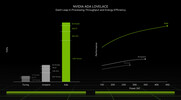NVIDIA RTX 4000 Ada Generation Laptop GPU vs Intel HD Graphics (Broadwell) vs Intel HD Graphics 5600
NVIDIA RTX 4000 Ada Generation Laptop GPU
► remove from comparison
The Nvidia RTX 4000 Ada Generation, not to be confused with the A4000, P4000 or RTX 4000 Turing Generation, is a very powerful professional graphics card for use in laptops that sports 7,424 CUDA cores and 12 GB of ECC GDDR6 VRAM. Brought into existence in 2023, this graphics adapter leverages TSMC's 5 nm process and Nvidia's Ada Lovelace architecture to achieve great performance combined with moderate power consumption. The Nvidia-recommended TGP range for the card is very wide at 60 W to 175 W leading to bizarre performance differences between different systems powered by what is supposed to be the same product.
Hardware-wise, the RTX 4000 is a GeForce RTX 4080 Laptop in disguise. Consequently, both make use of the AD103 chip and have little difficulty running triple-A games at QHD 1440p.
Quadro series graphics cards ship with much different BIOS and drivers than GeForce cards and are targeted at professional users rather than gamers. Commercial product design, large-scale calculations, simulation, data mining, 24 x 7 operation - if any of this sounds familiar, then a Quadro card will make you happy.
Architecture and Features
Ada Lovelace brings a range of improvements over older graphics cards utilizing the outgoing Ampere architecture. It's not just a better manufacturing process and a higher number of CUDA cores that we have here (up to 16,384 versus 10,752); under-the-hood refinements are plentiful, including an immensely larger L2 cache and an optimized ray tracing routine (a different way to determine what is transparent and what isn't is used) and other changes. Naturally, these graphics cards can both encode and decode some of the most widely used video codecs, AVC, HEVC and AV1 included; they also support a host of Nvidia technologies, including Optimus and DLSS 3, and they can certainly be used for various AI tasks.
The RTX 4000 features 58 RT cores of the 3rd generation, 232 Tensor cores of the 4th generation and 7,424 CUDA cores, making it a lot faster than the RTX 3500 Ada Generation. Elsewhere, the graphics card comes with 12 GB of 192-bit wide ECC GDDR6 memory for a very healthy throughput of ~432 GB/s. Error correction can be turned off if desired. The fact that error correction is present here proves that the RTX 4000 is indeed targeted at professional users.
Just like Ampere-based cards, the RTX 4000 makes use of the PCI-Express 4 protocol. 8K SUHD monitors are supported, however DP 1.4a video outputs can potentially prove to be a bottleneck down the line.
Performance
With its power target set to ~130 W, the Ada Generation graphics card delivers a Blender Classroom v3.3 CUDA score of 22 seconds which is a very good result. All 2024 games are playable at 1440p with the highest settings possible on this GPU.
Nvidia's marketing materials mention "up to 33.5 TFLOPS" of performance which is pretty impressive. The RTX 5000 Ada Generation is good for a little over 42 TFLOPS, for reference.
Your mileage may vary depending on how competent the cooling solution of your laptop is and how high the TGP power target of the RTX 4000 is. One other thing worth mentioning is that enabling error correction appears to reduce the amount of video memory that is available to applications and games by up to a gigabyte.
Power consumption
Nvidia no longer divides its laptop graphics cards into Max-Q and non-max-Q models. Instead, laptop makers are free to set the TGP according to their needs, and the range can sometimes be shockingly wide. This is the case with the RTX 4000, as the lowest value recommended for it sits at just 60 W while the highest is more than two times higher at 175 W (this most likely includes Dynamic Boost). The slowest system built around an RTX 4000 Ada can easily be 60% slower than the fastest one. This is the kind of delta that we've already seen on consumer-grade laptops featuring the latest GeForce RTX cards.
Last but not the least, the improved 5 nm process (TSMC 4N) the RTX 4000 Ada is built with makes for very decent energy efficiency, as of mid 2023.
Intel HD Graphics (Broadwell)
► remove from comparison
The Intel HD Graphics (Broadwell) (GT1) is an integrated Broadwell graphics card revealed in Q1 2015. It can be found in several low-end CPUs such as the Pentium 3805U or Celeron 3755U. The so-called GT1 GPU offers 12 EUs (Execution Units) and therefore somewhat more shader power than the previous HD Graphics (Haswell). The clock range may depend on the specific model it is built into.
Architecture and Features
Broadwell features a GPU based on the Intel Gen8 architecture, which has been optimized in various aspects compared to the previous Gen7.5 (Haswell). In case of the GT1 version, the shader arrays called "subslice" have been reorganized and now offer 6 Execution Units (EUs) each. Two subslices form a "slice" for a total of 12 EUs. Combined with other improvements such as larger L1 caches and an optimized frontend, the integrated GPU has become faster and more efficient than its predecessor.
The HD Graphics (Broadwell) represents the low-end version of the Broadwell GPU family and consists of one slice with 12 EUs. Beyond that, there is also a mid-range variant (GT2, 24 EUs) as well as higher-end models (GT3/GT3e + eDRAM, 48 EUs).
All Broadwell GPUs support OpenCL 2.0 and DirectX 12 (FL 11_1). The video engine can now decode H.265 using both fixed function hardware as well as available GPU shaders. Up to three displays can be connected via DP 1.2/eDP 1.3 (max. 3840 x 2160 @ 60 Hz) or HDMI 1.4a (max. 3840 x 2160 @ 24 Hz). HDMI 2.0, however, is not supported.
Performance
Even though the HD Graphics (Broadwell) is clocked a bit lower, the performance should be clearly above the HD Graphics (Haswell) and similar to the HD Graphics 4000. Nevertheless, only a few games as of 2014/2015 will run fluently at (very) low settings, e.g. Dota 2 or Sims 4.
Power Consumption
Utilizing a new 14 nm process, the HD Graphics (Broadwell) can be found in ULV models (15 W) as well as regular dual core CPUs (37 W, not yet presented). The TDP is flexible and can be further reduced, which has a significant impact on performance.
Intel HD Graphics 5600
► remove from comparison
The Intel HD Graphics 5600 (GT2) is an integrated graphics card of the Broadwell generation. It can be found in standard voltage CPUs (47 W) and offers 24 EUs (Execution Units). The clock range may depend on the model it is built into (Core i7-5700HQ: max. 1050 MHz with Turbo Boost).
Architecture and Features
Broadwell features a GPU based on the Intel Gen8 architecture, which has been optimized in various aspects compared to the previous Gen7.5 (Haswell). Inter alia, the shader arrays called "subslice" have been reorganized and now offer 8 Execution Units (EUs) each. Three subslices form a "slice" for a total of 24 EUs. Combined with other improvements such as larger L1 caches and an optimized frontend, the integrated GPU has become faster and more efficient than its predecessor.
The HD Graphics 5600 represents the mid-range version of the Broadwell GPU family and consists of one slice with 24 EUs. Beyond that, there is also a low-end variant (GT1, 12 EUs) as well as higher-end models (GT3/GT3e + eDRAM, 48 EUs).
All Broadwell GPUs support OpenCL 2.0 and DirectX 12 (FL 11_1). The video engine is now able to decode H.265 using both fixed function hardware as well as available GPU shaders. Up to three displays can be connected via DP 1.2/eDP 1.3 (max. 3840 x 2160 @ 60 Hz) or HDMI 1.4a (max. 3840 x 2160 @ 24 Hz). HDMI 2.0, however, is not supported.
Performance
Thanks to its improved architecture and the additional EUs, the HD Graphics 5600 is about 20 percent faster than the Haswell-based HD 4600 (20 EUs), but still somewhat slower than dedicated low-end GPUs like a GeForce 920M or Radeon R7 M360. Most games as of 2014/2015 will be playable only in low settings (and sometimes not even that).
Power Consumption
The whole Broadwell chip is specified at 47 W TDP (i7-5700HQ) and therefore best suited for notebooks 14-inches in size and above. We tested the power consumption of the GPU with HWInfo sensors in a Core i7-5600HQ (MSI GP62). Idle on the Windows desktop the HD 5600 needed on average 0.04 Watt. Running World of Warships in high details, 9.6 Watt were used by the graphics card (whole CPU needed 41 Watt). In comparison, when we activated the dedicated GeForce 940M, the GPU part needed 0.4 Watt and the whole CPU 29 Watt.
| NVIDIA RTX 4000 Ada Generation Laptop GPU | Intel HD Graphics (Broadwell) | Intel HD Graphics 5600 | ||||||||||||||||||||||||||||||||||||||||||||||||||||||||||||||||||||||||||||||||||||||||||||||||||||||||||||||||||||||||||||||||||||||||||||||||||||||||||||||||
| HD Graphics Series |
|
|
| |||||||||||||||||||||||||||||||||||||||||||||||||||||||||||||||||||||||||||||||||||||||||||||||||||||||||||||||||||||||||||||||||||||||||||||||||||||||||||||||
| Architecture | Ada Lovelace | Gen. 8 Broadwell | Gen. 8 Broadwell | |||||||||||||||||||||||||||||||||||||||||||||||||||||||||||||||||||||||||||||||||||||||||||||||||||||||||||||||||||||||||||||||||||||||||||||||||||||||||||||||
| Pipelines | 7424 - unified | 12 - unified | 24 - unified | |||||||||||||||||||||||||||||||||||||||||||||||||||||||||||||||||||||||||||||||||||||||||||||||||||||||||||||||||||||||||||||||||||||||||||||||||||||||||||||||
| Raytracing Cores | 58 | |||||||||||||||||||||||||||||||||||||||||||||||||||||||||||||||||||||||||||||||||||||||||||||||||||||||||||||||||||||||||||||||||||||||||||||||||||||||||||||||||
| Tensor / AI Cores | 232 | |||||||||||||||||||||||||||||||||||||||||||||||||||||||||||||||||||||||||||||||||||||||||||||||||||||||||||||||||||||||||||||||||||||||||||||||||||||||||||||||||
| Theoretical Performance | 33.6 TFLOPS FP32 | |||||||||||||||||||||||||||||||||||||||||||||||||||||||||||||||||||||||||||||||||||||||||||||||||||||||||||||||||||||||||||||||||||||||||||||||||||||||||||||||||
| Memory Speed | 16000 effective = 2000 MHz | |||||||||||||||||||||||||||||||||||||||||||||||||||||||||||||||||||||||||||||||||||||||||||||||||||||||||||||||||||||||||||||||||||||||||||||||||||||||||||||||||
| Memory Bus Width | 192 Bit | 64/128 Bit | 64/128 Bit | |||||||||||||||||||||||||||||||||||||||||||||||||||||||||||||||||||||||||||||||||||||||||||||||||||||||||||||||||||||||||||||||||||||||||||||||||||||||||||||||
| Memory Type | GDDR6 | |||||||||||||||||||||||||||||||||||||||||||||||||||||||||||||||||||||||||||||||||||||||||||||||||||||||||||||||||||||||||||||||||||||||||||||||||||||||||||||||||
| Max. Amount of Memory | 12 GB | |||||||||||||||||||||||||||||||||||||||||||||||||||||||||||||||||||||||||||||||||||||||||||||||||||||||||||||||||||||||||||||||||||||||||||||||||||||||||||||||||
| Shared Memory | no | yes | yes | |||||||||||||||||||||||||||||||||||||||||||||||||||||||||||||||||||||||||||||||||||||||||||||||||||||||||||||||||||||||||||||||||||||||||||||||||||||||||||||||
| Memory Bandwidth | 432 GB/s | |||||||||||||||||||||||||||||||||||||||||||||||||||||||||||||||||||||||||||||||||||||||||||||||||||||||||||||||||||||||||||||||||||||||||||||||||||||||||||||||||
| API | DirectX 12 Ultimate, Shader 6.7, OpenGL 4.6, OpenCL 3.0, Vulkan 1.3 | DirectX 12 (FL 11_1), OpenGL 4.3 | DirectX 12 (FL 11_1), OpenGL 4.3 | |||||||||||||||||||||||||||||||||||||||||||||||||||||||||||||||||||||||||||||||||||||||||||||||||||||||||||||||||||||||||||||||||||||||||||||||||||||||||||||||
| Power Consumption | 150 Watt (60 - 150 Watt TGP) | |||||||||||||||||||||||||||||||||||||||||||||||||||||||||||||||||||||||||||||||||||||||||||||||||||||||||||||||||||||||||||||||||||||||||||||||||||||||||||||||||
| technology | 5 nm | 14 nm | 14 nm | |||||||||||||||||||||||||||||||||||||||||||||||||||||||||||||||||||||||||||||||||||||||||||||||||||||||||||||||||||||||||||||||||||||||||||||||||||||||||||||||
| PCIe | 4.0 x16 | |||||||||||||||||||||||||||||||||||||||||||||||||||||||||||||||||||||||||||||||||||||||||||||||||||||||||||||||||||||||||||||||||||||||||||||||||||||||||||||||||
| Displays | 4 Displays (max.), HDMI 2.1, DisplayPort 1.4a | |||||||||||||||||||||||||||||||||||||||||||||||||||||||||||||||||||||||||||||||||||||||||||||||||||||||||||||||||||||||||||||||||||||||||||||||||||||||||||||||||
| Notebook Size | large | |||||||||||||||||||||||||||||||||||||||||||||||||||||||||||||||||||||||||||||||||||||||||||||||||||||||||||||||||||||||||||||||||||||||||||||||||||||||||||||||||
| Date of Announcement | 21.03.2023 | 05.01.2015 | 02.06.2015 | |||||||||||||||||||||||||||||||||||||||||||||||||||||||||||||||||||||||||||||||||||||||||||||||||||||||||||||||||||||||||||||||||||||||||||||||||||||||||||||||
| Link to Manufacturer Page | images.nvidia.com | |||||||||||||||||||||||||||||||||||||||||||||||||||||||||||||||||||||||||||||||||||||||||||||||||||||||||||||||||||||||||||||||||||||||||||||||||||||||||||||||||
| Predecessor | RTX A3000 Laptop GPU | |||||||||||||||||||||||||||||||||||||||||||||||||||||||||||||||||||||||||||||||||||||||||||||||||||||||||||||||||||||||||||||||||||||||||||||||||||||||||||||||||
| Codename | Broadwell GT1 | Broadwell GT2 | ||||||||||||||||||||||||||||||||||||||||||||||||||||||||||||||||||||||||||||||||||||||||||||||||||||||||||||||||||||||||||||||||||||||||||||||||||||||||||||||||
| Core Speed | 100 - 850 (Boost) MHz | 300 - 1050 (Boost) MHz | ||||||||||||||||||||||||||||||||||||||||||||||||||||||||||||||||||||||||||||||||||||||||||||||||||||||||||||||||||||||||||||||||||||||||||||||||||||||||||||||||
| Features | QuickSync | QuickSync |
|
| |||||||||||||||||||||||||||||||||
Benchmarks
3DM Vant. Perf. total + Intel HD Graphics (Broadwell)
specvp12 sw-03 + NVIDIA RTX 4000 Ada Generation Laptop GPU
Cinebench R15 OpenGL 64 Bit + NVIDIA RTX 4000 Ada Generation Laptop GPU
GFXBench T-Rex HD Offscreen C24Z16 + Intel HD Graphics (Broadwell)
Average Benchmarks NVIDIA RTX 4000 Ada Generation Laptop GPU → 100% n=7
Average Benchmarks Intel HD Graphics (Broadwell) → 3% n=7
Average Benchmarks Intel HD Graphics 5600 → 6% n=7
* Smaller numbers mean a higher performance
1 This benchmark is not used for the average calculation
Game Benchmarks
The following benchmarks stem from our benchmarks of review laptops. The performance depends on the used graphics memory, clock rate, processor, system settings, drivers, and operating systems. So the results don't have to be representative for all laptops with this GPU. For detailed information on the benchmark results, click on the fps number.

Baldur's Gate 3
2023
F1 22
2022
Fallout 76
2018
Far Cry 5
2018
X-Plane 11.11
2018
Team Fortress 2
2017
Rocket League
2017
Watch Dogs 2
2016
Dishonored 2
2016
Farming Simulator 17
2016
Battlefield 1
2016
FIFA 17
2016
The Division
2016
Far Cry Primal
2016
Just Cause 3
2015
FIFA 16
2015
World of Warships
2015
Metal Gear Solid V
2015
Dota 2 Reborn
2015
The Witcher 3
2015
Dirt Rally
2015
GTA V
2015
Battlefield Hardline
2015
Evolve
2015
Far Cry 4
2014
F1 2014
2014
Ryse: Son of Rome
2014
Alien: Isolation
2014
Fifa 15
2014
Sims 4
2014
GRID: Autosport
2014
Watch Dogs
2014
Thief
2014
Battlefield 4
2013
Metro: Last Light
2013
BioShock Infinite
2013
Tomb Raider
2013
Crysis 3
2013
Hitman: Absolution
2012
Counter-Strike: GO
2012
Diablo III
2012Average Gaming NVIDIA RTX 4000 Ada Generation Laptop GPU → 100%
Average Gaming 30-70 fps → 100%
Average Gaming Intel HD Graphics 5600 → 4%
| NVIDIA RTX 4000 Ada Generation Laptop GPU | Intel HD Graphics (Broadwell) | Intel HD Graphics 5600 | |||||||||||||||||||
|---|---|---|---|---|---|---|---|---|---|---|---|---|---|---|---|---|---|---|---|---|---|
| low | med. | high | ultra | QHD | 4K | low | med. | high | ultra | QHD | 4K | low | med. | high | ultra | QHD | 4K | ||||
| Cyberpunk 2077 2.2 Phantom Liberty | 129.3 | 115.1 | 108.4 | 98.3 | 68.5 | ||||||||||||||||
| Baldur's Gate 3 | 178.3 | 160.6 | 141.6 | 137 | 90.7 | ||||||||||||||||
| F1 22 | 275 | 264 | 238 | 95.5 | 65.7 | ||||||||||||||||
| Tiny Tina's Wonderlands | 275.4 | 232.6 | 171.4 | 137.1 | 92 | ||||||||||||||||
| Strange Brigade | 452 | 372 | 323 | 292 | 210 | ||||||||||||||||
| Far Cry 5 | 168 | 148 | 138 | 128 | 125 | ||||||||||||||||
| X-Plane 11.11 | 166.8 | 144 | 113.1 | ||||||||||||||||||
| Final Fantasy XV Benchmark | 207 | 185.3 | 150 | 119.5 | 8.7 | ||||||||||||||||
| Dota 2 Reborn | 215.4 | 189.7 | 185.2 | 164.4 | |||||||||||||||||
| GTA V | 185.8 | 183.9 | 179.4 | 125.6 | 118.7 | ||||||||||||||||
| NVIDIA RTX 4000 Ada Generation Laptop GPU | Intel HD Graphics (Broadwell) | Intel HD Graphics 5600 | |||||||||||||||||||
| low | med. | high | ultra | QHD | 4K | low | med. | high | ultra | QHD | 4K | low | med. | high | ultra | QHD | 4K | < 30 fps < 60 fps < 120 fps ≥ 120 fps | 10 | 1 9 | 2 8 | 2 6 | 6 2 | | < 30 fps < 60 fps < 120 fps ≥ 120 fps | | | | | | | < 30 fps < 60 fps < 120 fps ≥ 120 fps | 1 | | | | | |
For more games that might be playable and a list of all games and graphics cards visit our Gaming List


































